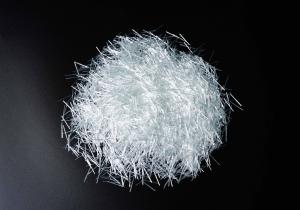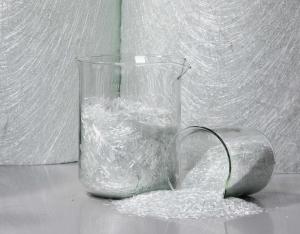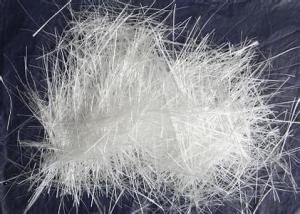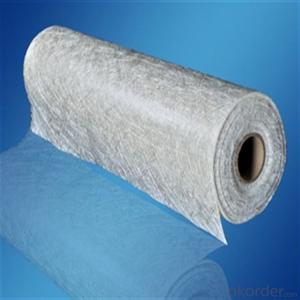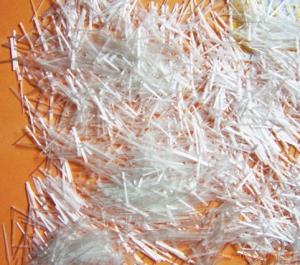558 E Glass Fiber Chopped Strands For BMC
- Loading Port:
- Shanghai
- Payment Terms:
- TT or LC
- Min Order Qty:
- 1000 kg
- Supply Capability:
- 1000000 kg/month
OKorder Service Pledge
OKorder Financial Service
You Might Also Like
558 Chopped Strands
558 Chopped Strands are specifically designed to reinforce phenolic resin. They are coated with a silane-based sizing and have excellent dry flowability and strand dispersion. 558 are designed for use in the compression molding process to manufacture automobile brake shoe facings, clutch facings, and friction plates.
Product Features:
·Good strand integrity and low static
·Low fuzz and good flowability
·Fast and uniform distribution in resins and good processing properties
·Good mechanical properties
Technical Parameters:
Item | Filament diameter variation | Moisture content | Sizing content | Chopped length variation | Choppability |
Unit | % | % | % | mm | % |
Test menthod | ISO 1888 | ISO 3344 | ISO 1887 | Q/JS J0361 | Q/JS J0362 |
Standard range | ± 10 | ≤ 0.07 | 0.85 ± 0.15 | ± 1.00 | ≥ 99.00 |
Typical chopped length (mm):3mm,4.5mm,6mm,12mm
Instructions:
·The product is best used within 12 months after production, and should be kept in the original package before use.
·Care should be taken when using the product to prevent it from being scratched or damaged.
·The temperature and humidity of the product should be conditioned to be close or equal to the ambient temperature and humidity before use, and the ambient temperature and humidity should be properly controlled during the use.
Packaging:
The product can be packed in container bags or woven bags:
- A container bag can hold 900kg~1200kg of products, with the standard weight being 1000kg.
- A woven bag can hold 15kg~30kg of products, with the standard weight being 25kg.
Container bag size:
Length mm(in):990 (38.98)
Width mm(in) :990 (38.98)
Height mm(in) :1100 (43.31)
Woven bag size:
Length mm(in):850 (33.46)
Width mm(in) :500 (19.69)
Height mm(in) :120 (4.72)
Storage:
Unless otherwise specified, the fiberglass products should be stored in a dry,cool and moisture-proof area.The best temperature and humidity should be maintained at -10℃~35℃ and ≤80% respectively. To ensure safety and avoid damage to the product, the pallets should be stacked not more than three layers high. When the pallets are stacked in two or three layers, special care should be taken to correctly and smoothly move the upper pallet
- Q:Is fiberglass chopped strand suitable for construction reinforcement applications?
- Yes, fiberglass chopped strand is suitable for construction reinforcement applications. It is commonly used in the construction industry to reinforce concrete and other building materials due to its high strength, durability, and corrosion resistance properties. Additionally, it is lightweight and easy to handle, making it an ideal choice for construction projects.
- Q:Can fiberglass chopped strand be used in electrical insulation?
- Yes, fiberglass chopped strand can be used in electrical insulation. It has excellent electrical insulation properties and is often used in applications where insulation is required, such as electrical panels and wiring.
- Q:Characteristics of carbon fiber
- At present, the world's carbon fiber production reached 40 thousand tons per year, the situation will not change a lot, In the past 20 years, 3K, Lombardy will exceed 5000 tons in 2010. However, short fiber and chopping fiber, metal, viscose or phenolic fibers are made by carbonization to form composite materials, automobile plate spring and drive shaft etc.. .
- Q:How does the fiber diameter affect the properties of fiberglass chopped strand?
- The properties of fiberglass chopped strand are significantly influenced by the diameter of its fibers. The strength, flexibility, and overall performance of the fiberglass are directly impacted by the fiber diameter. When the fiber diameter is smaller, it generally leads to increased strength and stiffness of the chopped strand. This is because the smaller fibers can tightly pack together, resulting in a higher fiber volume fraction and enhancing the material's load-bearing capacity. Additionally, smaller fibers tend to have fewer defects, further improving their strength. On the other hand, larger fiber diameters can contribute to increased flexibility and impact resistance of the chopped strand. The larger fibers provide more space for movement and deformation, allowing the material to absorb and dissipate energy during impacts or bending. This can be advantageous in applications where toughness and resilience are crucial, like automotive parts or sports equipment. The fiber diameter also affects the surface area of the chopped strand. Smaller fibers have a greater surface area per unit volume, which enhances the bonding and adhesion of the fibers with the resin matrix. This results in improved mechanical properties, including increased tensile strength and better resistance to delamination. Moreover, the processing characteristics of the chopped strand are influenced by the fiber diameter. Smaller fibers disperse more easily in the resin, leading to a more homogeneous mixture and overall better performance. Conversely, larger fibers may require additional processing steps, such as chopping or grinding, to achieve proper dispersion and ensure uniformity in the final product. To summarize, the fiber diameter of fiberglass chopped strand is crucial in determining its mechanical, processing, and performance properties. The selection of the appropriate fiber diameter depends on the specific requirements of the application, considering factors like strength, flexibility, impact resistance, and processability.
- Q:Does fiberglass chopped strand have any water absorption properties?
- The absence of water absorption properties characterizes fiberglass chopped strand. This is due to its composition of inorganic materials, like glass fibers, which do not easily soak up water. Moreover, the manufacturing procedure frequently involves the application of binders or coatings that additionally decrease water absorption. Consequently, fiberglass chopped strand finds widespread use in situations necessitating resistance to moisture and water, including boat construction, automotive components, and roofing materials.
- Q:How does the fiber orientation affect the properties of fiberglass chopped strand?
- The fiber orientation plays a crucial role in determining the properties of fiberglass chopped strand. Fiberglass chopped strand is made up of short fibers that are randomly oriented within the material. The orientation of these fibers affects various mechanical properties of the fiberglass chopped strand, such as its strength, stiffness, and impact resistance. When the fibers are aligned in a specific direction, the material becomes stronger and stiffer along that axis. This is known as the longitudinal direction. On the other hand, when the fibers are randomly oriented, the material becomes isotropic, meaning it has similar properties in all directions. This can be advantageous in applications where the material needs to withstand forces from multiple directions, as it offers balanced strength and stiffness. Additionally, the fiber orientation also influences the material's resistance to cracking and delamination. When the fibers are aligned in the same direction as the applied stress, they can effectively distribute the load, reducing the likelihood of cracks forming or propagating. This is known as the load-bearing direction. Conversely, if the fibers are not aligned with the applied stress, the material may be more susceptible to crack initiation and propagation. In summary, the fiber orientation of fiberglass chopped strand significantly impacts its mechanical properties, including strength, stiffness, impact resistance, and crack resistance. Understanding and controlling the fiber orientation is crucial in designing and manufacturing fiberglass chopped strand to meet specific application requirements.
- Q:How does the flame retardancy of the chopped strand affect its performance?
- The flame retardancy of a chopped strand significantly affects its performance by providing resistance to fire and preventing the spread of flames. This makes the chopped strand suitable for applications where fire safety is crucial, as it reduces the risk of ignition and helps inhibit the spread of fire.
- Q:What is the water repellency of fiberglass chopped strand?
- The water repellency of fiberglass chopped strand may vary depending on the specific manufacturing process and any additional coatings or treatments applied to the material. In general, fiberglass chopped strand is recognized for its excellent water resistance due to its non-porous nature and the hydrophobic properties of the glass fibers. This signifies that the material is less likely to absorb water and more likely to form droplets that roll off its surface. However, it is important to acknowledge that fiberglass is not completely impermeable and can gradually absorb water if it is not adequately sealed or protected. Furthermore, factors such as the length and diameter of the fibers, as well as the orientation and distribution of the strands within the material, can also influence the water repellency of fiberglass chopped strand.
- Q:Can fiberglass chopped strand be used for reinforcing ceramic matrix composites?
- Yes, fiberglass chopped strand can be used for reinforcing ceramic matrix composites. It provides strength and improved mechanical properties to the composite material.
- Q:How does the thermal expansion of the chopped strand affect its performance?
- The thermal expansion of the chopped strand can significantly affect its performance in various ways. Firstly, thermal expansion refers to the tendency of a material to expand or contract when exposed to changes in temperature. In the case of chopped strand, which is typically made of a composite material such as fiberglass or carbon fiber, its thermal expansion can affect its dimensional stability. When exposed to high temperatures, the chopped strand can expand, causing it to lose its original shape and potentially leading to warping or distortion. This can be particularly problematic in applications where precise dimensions and tolerances are required, such as in automotive or aerospace industries. The thermal expansion can result in improper fit or alignment, compromising the overall performance and functionality of the components or structures that incorporate chopped strand. Additionally, the thermal expansion of chopped strand can also impact its mechanical properties. As the material expands or contracts due to temperature changes, it can induce internal stresses within the composite structure. These stresses can weaken the material, making it more susceptible to cracking, delamination, or failure under mechanical loads. This can reduce the overall strength and durability of the chopped strand, limiting its performance in applications that require high mechanical integrity. Moreover, the thermal expansion characteristics of chopped strand can also affect its compatibility with other materials and the bonding between them. Different materials have different coefficients of thermal expansion, which can cause differential expansion or contraction when they are combined. This can result in interfacial stresses and potential delamination or debonding at the interfaces, further compromising the performance and reliability of the composite structure. To mitigate the negative effects of thermal expansion, various strategies can be employed. For instance, the use of thermally stable resins or matrix materials can help reduce the overall thermal expansion of the chopped strand composite. Additionally, incorporating fibers or additives with lower coefficients of thermal expansion can also help to counterbalance the expansion of the chopped strand. Moreover, proper design considerations, such as incorporating expansion joints or providing sufficient clearance for expansion, can help accommodate the thermal expansion and minimize its detrimental effects on performance. In conclusion, the thermal expansion of chopped strand can have significant implications for its performance. It can lead to dimensional instability, mechanical weaknesses, and interfacial issues, ultimately affecting the overall functionality and reliability of the composite material. Therefore, understanding and managing the thermal expansion characteristics of chopped strand is essential for optimizing its performance in various applications.
1. Manufacturer Overview |
|
|---|---|
| Location | |
| Year Established | |
| Annual Output Value | |
| Main Markets | |
| Company Certifications | |
2. Manufacturer Certificates |
|
|---|---|
| a) Certification Name | |
| Range | |
| Reference | |
| Validity Period | |
3. Manufacturer Capability |
|
|---|---|
| a)Trade Capacity | |
| Nearest Port | |
| Export Percentage | |
| No.of Employees in Trade Department | |
| Language Spoken: | |
| b)Factory Information | |
| Factory Size: | |
| No. of Production Lines | |
| Contract Manufacturing | |
| Product Price Range | |
Send your message to us
558 E Glass Fiber Chopped Strands For BMC
- Loading Port:
- Shanghai
- Payment Terms:
- TT or LC
- Min Order Qty:
- 1000 kg
- Supply Capability:
- 1000000 kg/month
OKorder Service Pledge
OKorder Financial Service
Similar products
New products
Hot products
Related keywords

